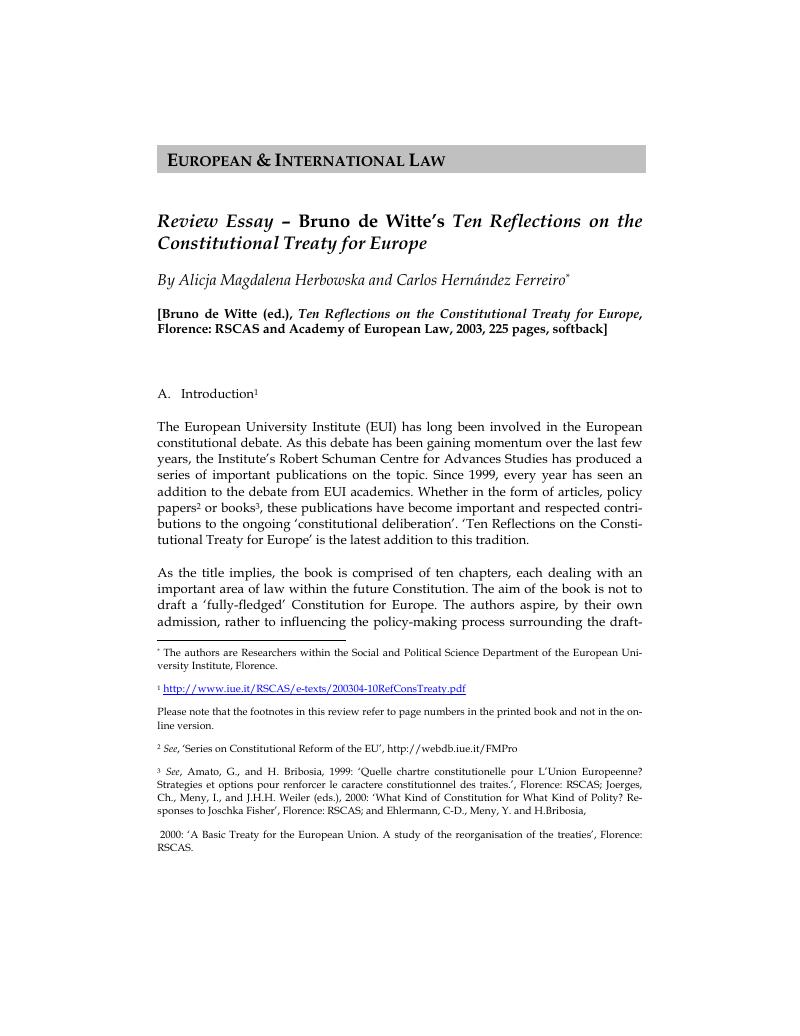Published online by Cambridge University Press: 06 March 2019

1 http://www.iue.it/RSCAS/e-texts/200304-10RefConsTreaty.pdf Google Scholar
Please note that the footnotes in this review refer to page numbers in the printed book and not in the online version.Google Scholar
2 See, ‘Series on Constitutional Reform of the EU', http://webdb.iue.it/FMPro Google Scholar
3 See, Amato, G., and Bribosia, H., 1999: ‘Quelle chartre constitutionelle pour L'Union Europeenne? Strategies et options pour renforcer le caractere constitutionnel des traites.', Florence: RSCAS; Joerges, Ch., Meny, I., and J.H.H. Weiler (eds.), 2000: ‘What Kind of Constitution for What Kind of Polity? Responses to Joschka Fisher', Florence: RSCAS; and Ehlermann, C-D., Meny, Y. and H. Bribosia, 2000: ‘A Basic Treaty for the European Union. A study of the reorganisation of the treaties', Florence: RSCAS.Google Scholar
4 We perceive the chapters on the preamble, the fundamental rights and citizenship and flexibility to fall somewhere in between the two abovementioned categories. One could argue that these are chapters dealing with main principles informing the Treaty, and therefore, with its material content. Yet we think they should be analysed within the limits of this review as they clearly influence the formal dimension of the Treaty.Google Scholar
5 Ten Reflections on the Constitutional Treaty for Europe, 4-5. The proposal made by the European Convention concludes the preamble in the following manner: ‘Grateful to the members of the European Convention for having prepared this Constitution on behalf of the citizens and States of Europe'.Google Scholar
6 Id., at 10Google Scholar
7 Id., at 6.Google Scholar
8 For an article detailing the available options for incorporation of the Charter, see, Michiel Brand, Towards the Definitive Status of the Charter of Fundamental Rights of the European Union: Political Document or Legally Binding Text, 4 German Law Journal No. 4, pp. 395–409 (1 April 2003), available at: http://www.germanlawjournal.com/article.php?id=261.Google Scholar
9 The Penelope Draft was a constitutional feasibility study produced at the request of the President of the Commission by Commissioners Barnier and Vittorino and published on 4th December 2002. It was a detailed document of 178 pages and is widely accepted to reflect the Commissions’ views on the constitutional debateGoogle Scholar
10 Ten Reflections, at 20.Google Scholar
11 Id., at 16.Google Scholar
12 Id., at 25-27.Google Scholar
13 Id., at 51.Google Scholar
14 Id., at 60.Google Scholar
15 Id., at 66.Google Scholar
16 See, Art. I-28.3, Art. III-266, and Art. III-277 of the Convention's constitutional proposal, http://european-convention.eu.int/docs/Treaty/cv00797-re01.en03.pdf and http://european-convention.eu.int/docs/Treaty/cv00725.en03.pdf. The authors acknowledge the possibility of a clear-cut definition of competencies producing system stagnation through an overloading of the ECJ with cases pertaining to the interpretation of the division of competencies. However, this should only be a short term problem. Moreover, the long term benefits of dividing competencies outweigh the potential problems. A clear-cut division of competencies would reduce information costs, would reduce institutional uncertainty and, last but not least, would improve political accountability.Google Scholar
17 Ten Reflections, at 47.Google Scholar
18 The authors of this review believe that a federalist interpretation of the division of competencies implies not only giving the majority of competencies to the constituent units, but also defining instruments to preserve the system's unity.Google Scholar
19 Jo Shaw is Professor of European Law at the University of ManchesterGoogle Scholar
20 Id., at 191.Google Scholar
21 Ten Reflections, at 70.Google Scholar
22 The judges are currently nominated by Member States’ governments (see, Art. 223 CE and 225 CE), which can create a situation of dependence. Many national nomination procedures also lack transparency; however, Art.I-28, par.2 of the Convention's draft repeats the current provisions, stating that the judges “shall be appointed by common accord of the governments of the Member States”.Google Scholar
23 Ten Reflections, at 86.Google Scholar
24 Id., at 97.Google Scholar
25 Id.Google Scholar
26 Id., at 108.Google Scholar
27 Id., at 111.Google Scholar
28 Id., at 124.Google Scholar
29 Id., at 126.Google Scholar
30 Id., at 207.Google Scholar
31 Other matters that should be included in this section are: repeal of existing treaties, territorial scope, legal status of annexed Protocols, duration, statement of official language versions.Google Scholar
32 Ten Reflections, at 211.Google Scholar
33 Id., at 213.Google Scholar
34 The author points to the fact that the Penelope Draft also affirms the need to adopt the “constitutional rupture” approach.Google Scholar
35 Id., at 216.Google Scholar
36 Id.Google Scholar
37 See, for an assessment of the listening phase at the Convention, the essay by Jesse Scott, The Culture of Constitution Making? “Listening” at the Convention on the Future of Europe?, 3 German Law Journal No. 9 (1 September 2002), available at: http://www.germanlawjournal.com/article.php?id=193). See, also, Johannes Jarlebring, Taking Stock of the European Convention: What added Value does the Convention Bring to the Process of Treaty Revision, 4 German Law Journal No. 8, pp. 785–799 (1 August 2003), available at: http://www.germanlawjournal.com/article.php?id=305.Google Scholar
38 A good example of such a bold intervention would be the now famous Joschka Fischer's speech at the Humboldt University in Berlin on 12th May 2000. See, hereto, the contributions in Joerges/Meny/Weiler, eds., supra note 3. See, also, Special Issue on the European Constitution, 2 German Law Journal No. 14 (1 September 2001), with contributions by former ECJ Justice Manfred Zuleeg, Federal Constitutional Court Judge, Udo Di Fabio, Armin von Bogdandy, Felix Arndt, Colette Mazzucelli, Uwe Säuberlich and Timo Tohidipur, available at: http://www.germanlawjournal.com (past issues, Vol. 2, issue 14).Google Scholar